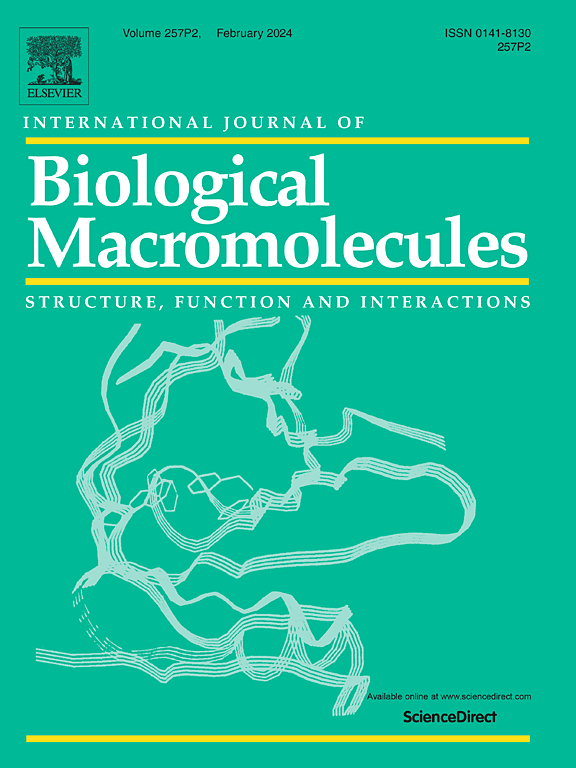AEBP1 or ACLP, which is the key factor in inflammation and fibrosis?
IF 8.5
1区 化学
Q1 BIOCHEMISTRY & MOLECULAR BIOLOGY
International Journal of Biological Macromolecules
Pub Date : 2025-04-26
DOI:10.1016/j.ijbiomac.2025.143554
引用次数: 0
Abstract
Adipocyte enhancer-binding protein 1 (AEBP1) and Aortic carboxypeptidase-like protein (ACLP) are two protein isoforms produced by the AEBP1 gene. AEBP1, originally discovered in preadipocytes, functions as a transcriptional repressor and is involved in promoting inflammation, proliferation, and migration through various signaling pathways. ACLP is an extracellular matrix protein linked to Ehlers-Danlos syndrome, a genetic disorder characterized by defective connective tissue development. Structurally, AEBP1 and ACLP share many similarities, and both participate in critical physiological or pathological processes, such as cancer and fibrosis, by influencing pathways like NK-κB, WNT, and TGF-β. In recent years, research on AEBP1 and ACLP has expanded to include major organs such as the brain, kidneys, and lungs, with a particular focus on the cardiovascular system, where they show potential as novel drug targets. However, most studies do not clearly distinguish between AEBP1 and ACLP. For instance, AEBP1 is implicated in myocardial fibrosis in hypertrophic cardiomyopathy models, whereas ACLP is associated with fibrosis in other organs. Additionally, literature on the relationship between AEBP1 and fibrosis is often contradictory. Clarifying the distinct roles of AEBP1 and ACLP and their different functions in various cell types would greatly benefit further research.
Current research suggests that the AEBP1 gene encodes two proteins, AEBP1 and ACLP, which have been reported to exhibit distinct functions in different studies. However, many studies do not differentiate between these two proteins, potentially leading to misconceptions. Therefore, we have conducted a comprehensive review of the existing literature to elucidate the functions of the AEBP1 gene and its encoded proteins in detail.
AEBP1还是ACLP,哪个是炎症和纤维化的关键因子?
脂肪细胞增强结合蛋白1 (AEBP1)和主动脉羧基肽酶样蛋白(ACLP)是AEBP1基因产生的两种蛋白亚型。AEBP1最初发现于前脂肪细胞中,作为一种转录抑制因子,通过多种信号通路参与促进炎症、增殖和迁移。ACLP是一种细胞外基质蛋白,与Ehlers-Danlos综合征(一种以结缔组织发育缺陷为特征的遗传性疾病)有关。在结构上,AEBP1和ACLP有许多相似之处,都通过影响NK-κB、WNT、TGF-β等通路参与关键的生理或病理过程,如癌症和纤维化。近年来,对AEBP1和ACLP的研究已经扩展到包括脑、肾和肺等主要器官,特别关注心血管系统,在心血管系统中它们显示出作为新型药物靶点的潜力。然而,大多数研究并没有明确区分AEBP1和ACLP。例如,AEBP1与肥厚性心肌病模型的心肌纤维化有关,而ACLP与其他器官的纤维化有关。此外,关于AEBP1与纤维化之间关系的文献经常是矛盾的。阐明AEBP1和ACLP在不同细胞类型中的不同作用及其不同功能,将有助于进一步的研究。目前的研究表明,AEBP1基因编码两种蛋白,AEBP1和ACLP,这两种蛋白在不同的研究中显示出不同的功能。然而,许多研究并没有区分这两种蛋白质,这可能会导致误解。因此,我们对现有文献进行了综合综述,详细阐明了AEBP1基因及其编码蛋白的功能。
本文章由计算机程序翻译,如有差异,请以英文原文为准。
求助全文
约1分钟内获得全文
求助全文
来源期刊
CiteScore
13.70
自引率
9.80%
发文量
2728
审稿时长
64 days
期刊介绍:
The International Journal of Biological Macromolecules is a well-established international journal dedicated to research on the chemical and biological aspects of natural macromolecules. Focusing on proteins, macromolecular carbohydrates, glycoproteins, proteoglycans, lignins, biological poly-acids, and nucleic acids, the journal presents the latest findings in molecular structure, properties, biological activities, interactions, modifications, and functional properties. Papers must offer new and novel insights, encompassing related model systems, structural conformational studies, theoretical developments, and analytical techniques. Each paper is required to primarily focus on at least one named biological macromolecule, reflected in the title, abstract, and text.

 求助内容:
求助内容: 应助结果提醒方式:
应助结果提醒方式:


